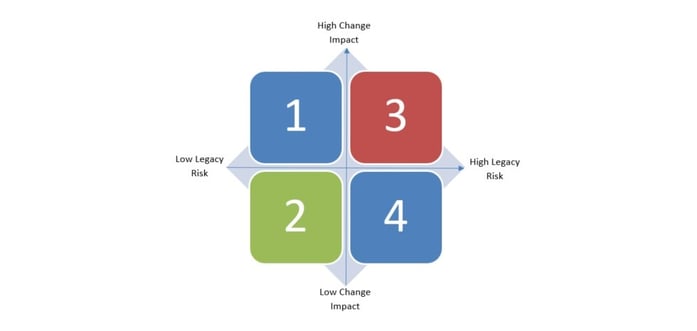Instincts are always good, but using actual people data early in the change process will strengthen your change planning. We use two key, yet simple, tools to measure change management people risks: the Change Impact Assessment (CIA) and the Initiative Legacy Assessment (ILA). These two change assessment tools will help you identify, understand and plan for people risks early in your change projects, and increase your ability to drive through successful change.

Using assessments and data to help shape your change management projects
Experienced change management leaders and change agents will often use their experience and their instinct, or gut-feel, to plan out a change project. But every change is slightly different, and every organization or team will have had a different experience with good, and bad, change implementations. Therefore, we always recommend complementing experience and instinct with data and analysis.
During the planning stage of a change project there are two assessment tools that will provide you with real data about people risks in your change project. Early identification of risks, with quantifiable data, allows your team to identify mitigating actions up front, and to track the progress of the risks throughout the change management lifecycle.
Change Impact Assessment (CIA)
 We use this assessment during the planning phase of a change project to start to understand what impact the change will have on different people and different teams across the organization. The CIA allows you to start thinking about the elements of the change that will impact people in their daily work.
We use this assessment during the planning phase of a change project to start to understand what impact the change will have on different people and different teams across the organization. The CIA allows you to start thinking about the elements of the change that will impact people in their daily work.
Purpose: measure and compare how difficult it might be for different individuals and groups to adapt to the change solutions. As a change leader it allows you to:
- Measure and compare likely disruption to different parts of the organization
- Identify areas or teams that might have difficulty with adapting and committing to the change
- Clearly identify risks in project risk logs
- Create dynamic change plans
Before starting your Change Impact Assessment, you will need to have a clear change description and elevator speech. We also recommend that you have completed a change network map to identify key individuals and groups who will be impacted by the change.
Pulling these together will allow you to target the right audience for the CIA, clearly communicate the assessments purpose and ensure you can clearly articulate the planned change itself.
Initiative Legacy Assessment (ILA)
This is the second assessment we use during the planning stage of a change project. The ILA allows us to understand the legacy of change implem entation done in the past. We all want to learn from the past to improve on the future, but too often we find that lessons from the past are just collected verbally, or through rumor or corridor talk.
entation done in the past. We all want to learn from the past to improve on the future, but too often we find that lessons from the past are just collected verbally, or through rumor or corridor talk.
While these are all important channels for informational and intelligence, asking specific target groups to identify in a simple assessment what went well, and what didn’t go so well, gives you some hard data to learn and plan from.
Purpose: provides you with an understanding of the key implementation challenges. As a change leader the ILA allows you to:
- Predict likely barriers and areas of resistance
- Predict likely levels of commitment
- Measure the effectiveness of past change
- Clearly identify risks in project risk logs
- Create dynamic change plans
Unlike the Change Impact Assessment, you don’t need to wait for a clear change description to be ready as the Initiative Legacy Assessment is based on peoples’ feeling about how past changes have been implemented.
Work out where to focus your risk mitigation efforts
Used together, these two tools provide a strong indication of where your risk mitigation effort should occur.
Used individually these two tools give your team excellent insight into people related risks. The outcome of the assessments and subsequent analysis should be the identification of your top risks and clearly defined mitigating actions that you have built into your change plans.
The benefit of targeting the same group of people for both assessments is that you can gain an even better insight into not only the high-risk areas, but the overlapping areas of high impact.
If we look at the matrix below, your project should concentrate its focus and energy in mitigating risks in quadrant 3, and maybe 1 or 4 (depending on specific risks) but not quadrant 2.

The Changefirst Change Impact Assessment and Initiative Legacy Assessment are both based on the 6 Critical Success Factors for change management, and measure 20 risk dimensions.
Used early, and then reviewed throughout your change project, these two change assessment tools will provide your change project with a proactive change management risks mitigation approach, and increase your ability to drive through successful change.
nformed by key people analytics to improve the quality of decision-making.
Is improving your digital ROI high on your Change Management agenda? |
|
|
|
The Change Impact Assessment and the Legacy Initiative Assessment are just two tools available with Roadmap Pro, our digital transformation toolkit which:
|




Leave a comment